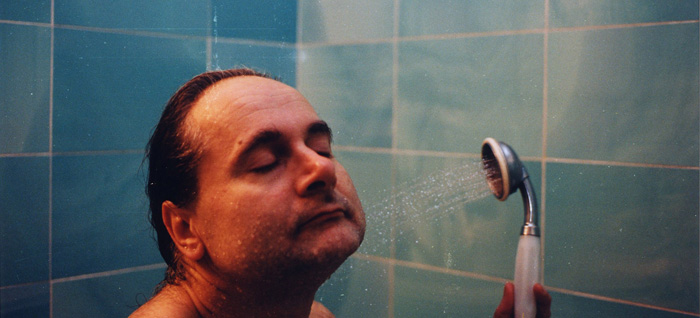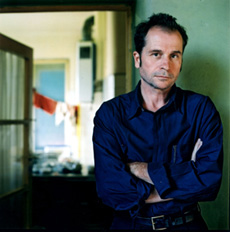Between Heaven and Hell

Resources
As part of this retrospective of the Austrian auteur's distinctive and provocative work, Ulrich Seidl visited Watershed to discuss his filmmaking and to introduce a special preview of Import/Export. To see a recording of this Director Q&A please visit: dshed.net/talks/ulrich-seidl
Ulrich Seidl Q&A
Interview by Mark Cosgrove, Watershed's Head of Programme and Anna Searle, Watershed's Programme Coordinator. Translated by Shirin Packham. With thanks to Trinity Filmed Entertainment.
Q. You came to filmmaking relatively late, starting at the Vienna Film Academy in your late 20s. What made you choose to go into film at that point?
On the one hand, I grew up in a strictly Catholic and patriarchal family and according to my parents’ wishes, I had to learn a “serious” profession. Training and working as an artist was unthinkable for my parents. The only thing they granted me was to follow my ambitions as a hobby. On the other hand – or maybe as a result of this situation – I was very insecure and full of awe towards the profession of a filmmaker. I needed time to put my secret desire into action and start studying film.

Q. You’ve got a very specific visual style. Had you already developed that through another medium – painting or photography – or is that something that came about as you learned to make films?
My primary interest was painting – for a long time I wanted to become a painter myself – and after that I turned to photography and toyed with the idea of becoming a cinematographer. Today, I am surprised, that my visual style already shows in my first short Einsvierzig which was shot during my time at the film academy in Vienna.
Q. What films or filmmakers have influenced your practice? And what outside of film influences you?
Regarding film, I have probably been influenced heavily by Jean Eustache, Luis Bunuel, P.P.Pasolini, Werner Herzog, John Cassavetes and also Erich von Stroheim. Regarding painting, I could name Hieronymus Bosch, Francisco Goya, Alfred Kubin, the Austrian sculptor Fritz Wotruba and the British artist David Hockney as influences. When it comes to photography, it’s mostly Diane Arbus’s work that has fascinated me for a long time.
Q. How do you find your subjects, most of whom are non-professional, and how do you work with them to get them to act so naturally in front of the camera, which often shows them in intimate and unflattering positions?
The search for actors starts from scratch with every new film and is a very time intensive process. I don’t distribute scripts and I don’t work from a set screen-play. The most important aspect about my work is building relationships based on mutual trust and gradually making actors develop a feeling for my ambition and the atmosphere of the film. If I succeed the actors (professional or non-professional) face the camera with an inner self-awareness that enables them to act naturally and authentically.
Q. When the recent imprisonment cases of Natascha Kampusch and the Fritzl family came to light, Austrians were quoted as saying that it is a particularly Austrian trait to turn a blind eye to what’s going on next door, to keep things functioning on the surface. You’ve been identifying this social disconnection in your films for quite some time, and as a result they’ve been quite provocative in Austria. Do you agree that this is an Austrian phenomenon, or are you finding this is the case elsewhere as you make films on a more international scale?
You have a point there. However, I am not sure if the tendency to turn a blind eye to certain issues can’t be found just as often in other countries. By the way, I am just preparing for a film with the title Im Keller (In the Basement) which will deal with this subject and with the attitude of Austrians towards their cellars.
Q. While your previous films look at interpersonal relationships within society, Import/Export takes a wider look at the economic and political forces which impact these relationships and individuals’ lives. What prompted your interest at looking at these systems and how did you go about infiltrating them – getting permission to shoot in the Gypsy tenement, nightclub, etc?
At the beginning of working on Import/Export, it was my intention to raise the issue of youth and unemployment; at the same time, I wanted to get out of Austria and make a film in Eastern Europe. We (that is Veronika Franz and myself) initially wrote seven or eight storylines, which were moving west to east or the other way around until we eventually decided to restrict ourselves to two stories. One of them - the story of the Ukrainian cleaning lady - can be found very often in Austria whereas the story of Pauli who moves east with his stepfather is pure fiction.
Regarding the filming permit, it was a lot harder to film in the Austrian geriatric hospital than in the gypsy community in Eastern Europe. Film permits quite often result from meeting people, trying to connect with them and from building up trust – just like with the gypsy community.
Q. You’ve worked with cinematographer Wolfgang Thaler for your last few films, so how did the addition of Ed Lachman to the team affect the way you worked? And how did he impact the final look of the film?
Ed Lachmann had noticed me and my films so we eventually met. I was excited by the idea of working in a team with two outstanding cinematographers like Lachmann and Thaler. Ed instantly agreed to this concept so I allowed myself the luxury. Ed Lachmann’s influence on the visual style only shows so much; I benefited more from his extensive experience as a cinematographer who has worked with some of the great international auteurs and also in Hollywood.
Q. How did the physical and emotional extremes during the shooting of Import/Export – freezing temperatures in winter in the Ukraine, as well as in an internet sex parlour and a home for the dying – affect the process?
I am convinced that extreme physical conditions during a shooting push the crew to their limits which sets free, through an enormous concentration and therefore challenge, special pictures and scenes. Scenes of a film are always the result of the circumstances they were filmed under. If you want your audience to feel the cold you have to expose yourself to the cold whilst shooting. Working on my films always means exposing me to the lives of others and getting emotionally involved. This can often be enriching, but at the same time very depressing. In either case, it has a big influence on the process of film making.
Q. As we celebrate the European Year of Intercultural Dialogue, Import/Export would indicate we have quite a way to go for ‘intercultural dialogue’. What are your thoughts on the European project?
We are living in times where the world is characterised by an enormous global gap between wealth and poverty and this gap is getting greater than it has ever been. We are living in times where the economy and its profits dictate life within society and where the liberties promised by a globalised world seemed to have turned to the contrary.
Q. Now you’ve moved outside Austria with Import/Export, will you continue to expand your filmic view to a more global scale?
Yes. Apart from the already mentioned Keller film which will focus on the Austrian mentality, there will, of course, be a next feature film project in which I will broaden my radius again. The film will consist of three storylines focusing on three women of the same family. One part of the film will examine the topics of sex tourism and tourism in Africa; the other part will tell the story of a religious missionary. All three stories will be about love, or, to be more precise, the struggle to find love.
